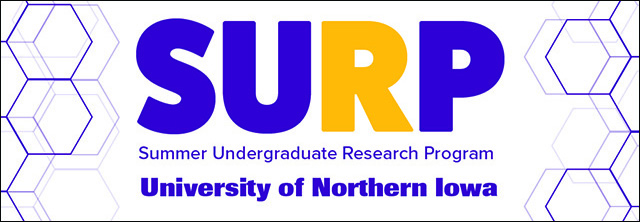
2023 Summer Undergraduate Research Program (SURP) Symposium
Location
ScholarSpace, Rod Library, University of Northern Iowa
Presentation Type
Open Access Poster Presentation
Document Type
poster
Keywords
Bees--Identification; Pollination by bees; Prairie plants--Iowa--Identification;
Abstract
The Iowa prairie is home to many species of bees who collect pollen for nutrition or nesting purposes (Real, 1983). Most bees collect pollen in their scopa, a small pollen collection pouch on their back legs or abdomen. However, the entire bee, including their thorax, can come in contact with pollen. Because of this, it is assumed that a bee’s pollen collection will be more diverse on its thorax where it unintentionally comes into contact with pollen, than its legs where it intentionally collects pollen. In this study, we created a comprehensive pollen library of native Iowa prairie flowers, and used it as a reference to analyze the pollen on various parts of a bee’s body. Pollen was collected off a plant’s anther using a glycerin fuchsin jelly cube, then photographed through a light microscope. Pollen was then collected off the leg and thorax of 25 different bees of various species. Pollen grains from the bees were identified into families using the plant pollen slides as references. The richness and the Shannon diversity of pollen grains on each bee’s leg and thorax was calculated and compared using the Wilcoxon signed rank test. No substantial difference was found between the diversity and richness of pollen grains from the leg and the thorax of each bee. This shows that even though wild bees might come into contact with flowers they do not collect pollen from using their other body parts, the pollen grain composition is not significantly different from the pollen grain in the scopa, which suggests the targeted flower species is the most effectively pollinated floral resource.
Start Date
28-7-2023 11:00 AM
End Date
28-7-2023 1:30 PM
Event Host
Summer Undergraduate Research Program, University of Northern Iowa
Faculty Advisor
Ai Wen
Department
Department of Biology
Copyright
©2023 Madeline Roubik and Dr. Ai Wen
Creative Commons License

This work is licensed under a Creative Commons Attribution-NonCommercial 4.0 International License
File Format
application/pdf
Recommended Citation
Roubik, Madeline and Wen, Ai, "Forming a Comprehensive Pollen Library for the Purpose of Native Bee Pollen Identification and Analysis" (2023). Summer Undergraduate Research Program (SURP) Symposium. 14.
https://scholarworks.uni.edu/surp/2023/all/14
Forming a Comprehensive Pollen Library for the Purpose of Native Bee Pollen Identification and Analysis
ScholarSpace, Rod Library, University of Northern Iowa
The Iowa prairie is home to many species of bees who collect pollen for nutrition or nesting purposes (Real, 1983). Most bees collect pollen in their scopa, a small pollen collection pouch on their back legs or abdomen. However, the entire bee, including their thorax, can come in contact with pollen. Because of this, it is assumed that a bee’s pollen collection will be more diverse on its thorax where it unintentionally comes into contact with pollen, than its legs where it intentionally collects pollen. In this study, we created a comprehensive pollen library of native Iowa prairie flowers, and used it as a reference to analyze the pollen on various parts of a bee’s body. Pollen was collected off a plant’s anther using a glycerin fuchsin jelly cube, then photographed through a light microscope. Pollen was then collected off the leg and thorax of 25 different bees of various species. Pollen grains from the bees were identified into families using the plant pollen slides as references. The richness and the Shannon diversity of pollen grains on each bee’s leg and thorax was calculated and compared using the Wilcoxon signed rank test. No substantial difference was found between the diversity and richness of pollen grains from the leg and the thorax of each bee. This shows that even though wild bees might come into contact with flowers they do not collect pollen from using their other body parts, the pollen grain composition is not significantly different from the pollen grain in the scopa, which suggests the targeted flower species is the most effectively pollinated floral resource.


